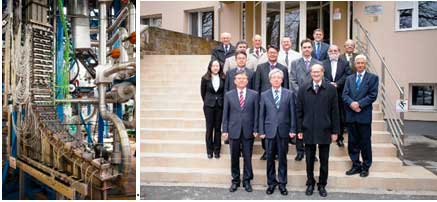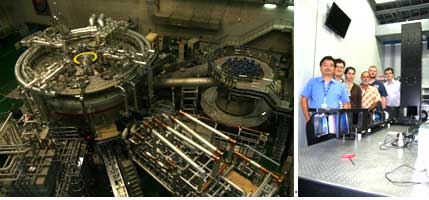
News from the Hungarian Nuclear Society
Establishment of Joint Hungarian-Korean Nuclear Laboratories
The Joint Hungarian-Korean Laboratory for Advancement of Nuclear Thermal-Hydraulics Safety was opened in the Hungarian Academy of Sciences, Centre for Energy Research on 25 March 2013. Thermal hydraulic experiments will be carried out in the laboratory in order to simulate accident conditions in nuclear power plants. During the first year of the work programme the propagation of shock waves after a large break loss-of-coolant-accident will be simulated in the test facility. The experimental programme will be carried out by a joint team of Korean and Hungarian experts from the Korean Atomic Energy Research Institute and from the Hungarian Academy of Sciences, Centre for Energy Research.

View of the thermal hydraulic facility (left) and the participants of the opening ceremony (right)
The Korean-Hungarian Joint Laboratory for Fusion Diagnostics was established at the Wigner Research Centre for Physics back in 2011 with the aim of jointly developing measurement systems (plasma diagnostics) for the KSTAR magnetic fusion facility in Daejeon, Korea. Some preparatory work started in 2010 with the construction of an experimental Beam Emission Spectroscopy (BES) system, which proved the viability of the technique for KSTAR in August 2011. This diagnostic works by observing the faint light emitter via a 100 keV deuterium atomic beam, heating the KSTAR plasma. The light intensity is nearly proportional to the plasma density, therefore information of the density distribution and plasma turbulence can be obtained. In 2011-12 a final BES system was constructed, installed and jointly operated. In 2012-13 this will be extended with the use of a low power 60 kV Lithium atomic beam injector, which should allow more precise measurements of the edge plasmas to be made.

View of the KSTAR facility (left) and members of the joint team for fusion diagnostics (right)
The creation of the joint laboratories was supported by the Korea Research Council of Fundamental Science and Technology and by the Hungarian Academy of Sciences.
|

